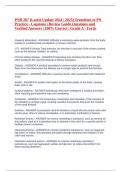PNR 207 (Latest Update ) Transition to PN
Practice - Capstone | Review Guide Questions and
Verified Answers | 100% Correct | Grade A - Fortis
Impaired elimination - ANSWER Difficulty in removing waste products from the body,
leading to conditions like constipation or urinary retention.
UTI - ANSWER Urinary Tract Infection, an infection in any part of the urinary system,
such as the kidneys, bladder, or urethra.
Chronic kidney disease - ANSWER Progressive loss of kidney function over time,
often leading to the need for dialysis or kidney transplant.
Dialysis - ANSWER A medical procedure to remove waste products and excess
fluids from the blood when the kidneys are no longer able to perform this function.
Constipation - ANSWER Difficulty in passing stools, often associated with hardened
feces.
Stroke - ANSWER A sudden interruption in the blood supply of the brain, causing
brain cells to die.
Surgical patients - ANSWER Individuals who have undergone a surgical procedure,
often requiring post-operative care and monitoring.
Peristalsis - ANSWER The involuntary constriction and relaxation of the muscles of
the intestine or another canal, creating wavelike movements that push the contents
of the canal forward.
Enemas - ANSWER A procedure used to introduce a liquid into the rectum and colon
via the anus, often to relieve constipation or to administer medication or barium.
Retention Enema - ANSWER An enema containing a substance, such as mineral oil,
that softens stool as it is absorbed and is retained in the colon for a specific period to
facilitate bowel movement.
Cleansing Enema - ANSWER An enema containing substances, such as soapsuds,
tap water, or saline, that stimulate peristalsis through distention and irritation of the
colon and rectum.
Distention reduction enema - ANSWER An enema containing carminative
substances, such as magnesium sulfate and glycerin, to relieve discomfort from
flatus causing distention.
, Medicated Enema - ANSWER An enema containing drugs, such as sodium
polystyrene or neomycin, to reduce bacteria or remove potassium from the body.
Disposable enema - ANSWER A pre-packaged enema, such as sodium phosphate
(fleet), used to stimulate peristalsis by acting as an irritant.
Immobilization - ANSWER The act of rendering someone or something immobile or
making them incapable of movement.
ROM - ANSWER Range of Motion exercises, aimed at preventing muscle
contractions and promoting venous blood circulation.
Skin protection - ANSWER Measures taken to prevent skin breakdown, such as
rotating the patient's position every 2 hours, using skin barriers, and protecting bony
areas.
Muscle atrophy - ANSWER A decrease in muscle mass due to immobility or lack of
use.
Pneumonia - ANSWER An infection that inflames the air sacs in one or both lungs,
which may fill with fluid or pus.
Osteoporosis - ANSWER A condition in which bones become weak and brittle.
Obese patient care - ANSWER Special considerations and precautions to be taken
when caring for an obese individual, such as using mechanical lifts and friction-
reducing sheets.
Dentures - ANSWER Artificial replacement for one or more natural teeth and
adjacent tissues.
Incontinence - ANSWER Involuntary loss of control over urination or defecation.
Urgency incontinence - ANSWER Involuntary loss of urine in response to a strong
sensation of need to empty the bladder.
Stress incontinence - ANSWER Urethral sphincter failure associated with increased
intra-abdominal pressure, as occurs with sneezing, laughing, coughing, and aerobic
exercise.
Mixed incontinence - ANSWER A combination of different types of incontinence,
such as stress and urgency incontinence.
Overflow incontinence - ANSWER Involuntary loss of urine due to poor contractility
of the bladder muscle and obstruction of the urethra.
Functional incontinence - ANSWER Incontinence caused by cognitive inability to
recognize the urge to urinate or physical impairment.




